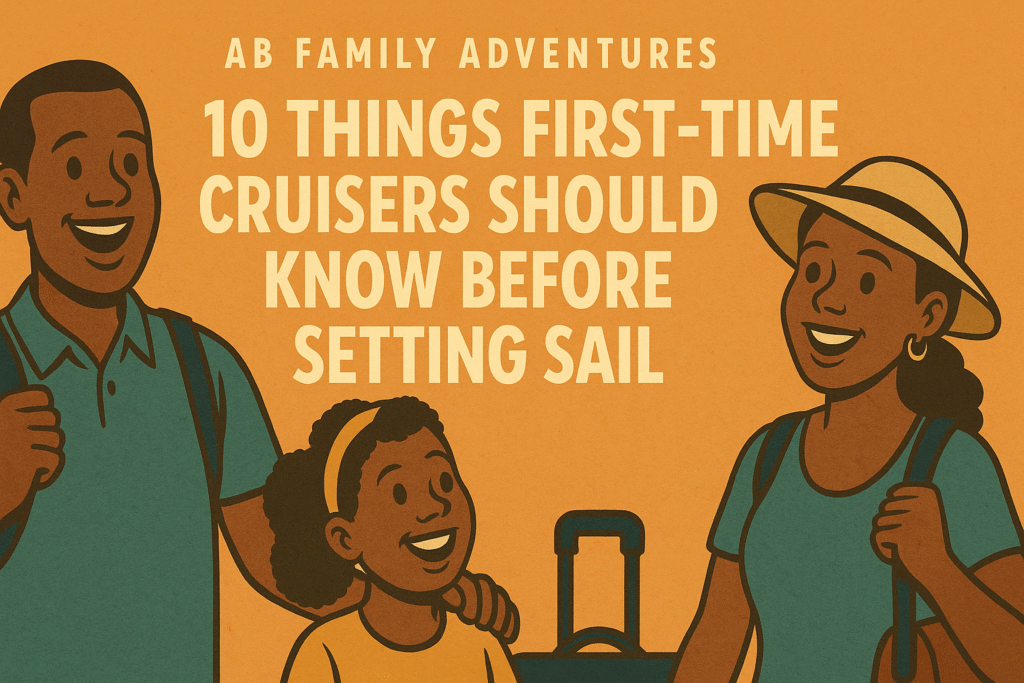
Taking your first cruise is a magical experience—but it can also feel like entering a whole new world of travel. Cruise ships are floating cities packed with food, entertainment, and family-friendly fun, but navigating them can be overwhelming if you don’t prepare.
To help you avoid confusion, overspending, or missed opportunities, we’ve compiled our top 10 cruise tips for first-time cruisers. These are the real-deal insights you don’t always find on cruise line brochures—and they’ll help your family cruise adventure start off right.

1. Arrive the Day Before Your Cruise
Why? Because anything can go wrong with flights. Delays, cancellations, lost luggage—you name it. Cruise ships are on tight schedules and will leave without you. Arriving the day before gives you peace of mind and time to unwind before boarding.
Pro Tip: Book a hotel near the cruise port that offers shuttle service to the terminal. It’s less stress and more time to bond with your family.

2. Pack a Carry-On Bag with Cruise Essentials
Even if you checked your luggage, it won’t be delivered to your cabin until later. Pack a carry-on with:
- Swimsuits
- Medications
- Travel documents & IDs
- Snacks or toys for the kids
- Sunscreen
- Change of clothes
You’ll thank yourself when you’re poolside while others are still waiting on bags.

3. Don’t Skip the Muster Drill (Safety Briefing)
Every cruise ship holds a mandatory muster drill to ensure passengers know emergency procedures. Skipping it isn’t an option—it’s essential for your safety and part of maritime law.
Most cruise lines now allow you to complete part of it via app or on-screen video in your cabin. Just don’t wait until the last minute!

4. Download the Cruise Line’s App Before You Sail
From deck maps to daily schedules, restaurant menus, and even onboard texting features—the cruise line app is your digital cruise assistant.
Make sure to download it before leaving home, as Wi-Fi at sea can be expensive. Most cruise apps work in airplane mode once you’re on board.

5. Research Ports Ahead of Time to Save Big
Excursions sold by the cruise line are convenient—but often pricier. Local vendors offer similar tours at a discount. Knowing what to expect lets you decide if you want to explore independently, hire a private guide, or join a group tour.

6. Budget for Daily Gratuities
Gratuities (tips) are automatically added to your onboard account—usually around $14–$20 per person per day. While it may feel like a surprise, it’s how cruise lines compensate hardworking crew members like cabin stewards and waiters.
You can prepay these before your cruise or settle them at the end.

7. You’ll Spend More Than You Expect—Plan for Extras
Your base fare includes meals, lodging, and most entertainment—but extras like soda packages, spa treatments, shore excursions, Wi-Fi, and tips add up.
Decide what’s worth the splurge. Want family portraits? Book a session. Want to avoid soda charges? Bring a reusable water bottle.

8. Bring a Lanyard and Magnetic Hooks
Your cruise card (SeaPass) is your room key, credit card, and ID. A lanyard helps you wear it around your neck and avoid losing it. And because cruise cabin walls are metal, magnetic hooks help hang hats, towels, wet swimsuits—keeping your tiny room organized.

9. Explore the Ship Early—Don’t Wait!
Use that first afternoon to explore. Find the pools, buffet, kids’ club, spa, quiet areas, and entertainment spaces. The ship is huge, and knowing where things are will help you enjoy every moment without wandering lost.

10. Be Ready for Unmatched Family Fun
Cruising offers a special kind of family magic: scavenger hunts, duck hiding games, waterslides, kids’ clubs, and movie nights under the stars. Try new things, get silly with your kids, and dive into the experience.
Cruises give families a rare chance to connect without distractions. Lean into it and make memories.


